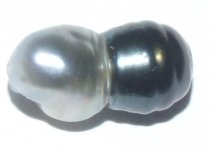Valeria101 said:
Just curious... what could be a desirable target of such research ? Achieving different and/or controlled colors sounds like the one thing achievable, while quantity and size are most in demand.
Well, I?m not sure I understand the question. Desirable target, as in who would be the end user of such research? Or what would be the hypothetical (as in ?desired?) outcome?
There is biological significance in this research. I think whoever does this, will prove (or disprove) the feasibility of xenotransplants between different marine and freshwater species. Then, after that, ?the world is your [pearl] oyster?? whether it works or not, then you move in the next direction.
The ?worst? that can happen is that it doesn?t work at all. There are so many levels of ?success? that I would say the probability of total failure is low.
For example, in that article that I mentioned before (Panha and Kosavititkul, 1997), they used three species, all freshwater, (Hyriopsis myersiana (Hm), H. desowitzi (Hd) and C. hainesiana (C)), and they obtained the following results of Allografts and Xenografts.
Donor, Recipient, Survival rate of grafts (%)
Hm, Hm, 96
C, Hm, 94
Hd, Hm, 83.9
Hd, Hd, 18.5
C, Hd, 0
Hm, Hd, 0
C, C, 97
Hm, C, 85.5
Hd, C, 26.2
(I wanted this to look like a table)
If you see, some of the xenografts showed better success than allografts. Also, some xenografts only ?worked? in one direction.
If Marine to Freshwater to Marine xenotransplants work, then you evaluate the success rate and the quality of the product you get. Then you can evaluate how profitable this would be.
The limit is your imagination, you could use mantle from different species of freshwater mussels to produce large -freswater looking?-cultured pearls in, for example Pinctada maxima.
What about grafting two pieces of tissue, one of each species, in the same incision? double colored pearl? Who knows? Someone will do it one day. I just hope they publish it.
I hope in some of all this I answered to your question
Hector


